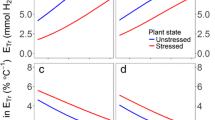Abstract
Transpiration rates of potted spray carnation plants Cerise Royalette decreased about 0.04% per vpm CO2 between ambient atmospheric CO2 concentration and 1500 vpm CO2 at several light flux densities and leaf temperatures. Measurements of daily water losses of potted spray carnation plants placed under high solar radiation conditions in two minigreenhouses with 300 and 5000 vpm CO2 demonstrated that elevated CO2 concentrations reduced water losses by 20–30%. The effect of the increase in global CO2 concentration on stomatal closure was calculated to have decreased the yearly transpiration rate of an outdoor crop by 1.6% in this century and is expected to cause a decrease of 10% within the next 50 years if all other factors remain unchanged. From a model of CO2 uptake of carnation plants it was calculated that the expected water use efficiency (net photosynthesis rate/transpiration rate) will increase by about 40–50% over the next 50 years due to the expected increase in global CO2 concentration.
Similar content being viewed by others
References
CALLENDAR, G. S. (1938): The artificial production of carbon dioxide. Quart. J. roy. meteor. Soc.,64 223–240.
COWAN, I. R. (1978): Water use in higher plants. In: Water, Planets, Plant and People. A. K. McIntyre (ed.) Australian Academy of Science, Canberra, 71–107.
EHLERINGER, J., and BJÖRKMAN, O. (1977): Quantum yields for CO2 uptake in C3 and C4 plants. Dependence on temperature, CO2 and O2 concentration. Plant Physiol.,59 86–90.
ENOCH, H. Z. (1977): Diurnal and seasonal variations in the carbon dioxide concentration of the lower atmosphere in the coastal plain of Israel. Agric Meteorol.,18 373–385.
ENOCH, H. Z. (1978a): A theory for optimalization of primary production in protected cultivation. Acta Hort.,76 31–57.
ENOCH, H. Z. (1978b): The role of carbon dioxide in productivity of crops under protected cultivation. Acta Hort.,87 125–129.
ENOCH, H. Z. and HURD, R. G. (1977): Effect of light intensity, carbon dioxide concentration, and leaf temperature on gas exchange of spray carnation plants. J. exp. Bot.28 84–95.
ENOCH, H. Z. and SACHS, J. M. (1978): An empirical model of CO2 Exchange of a C3 plant in relation to light, CO2 concentration and temperature. Photosynthetica,12 150–157.
ENOCH, H. Z., ZIESLIN, N., BIRAN, Y., HALEVY, A. H., SCHWARZ, M., KESLER, B. and SHIMSHI, D. (1973): Principles of CO2 nutrition research. Acta Hort.32 97–118.
HO, L. C. (1977): Effects of CO2 enrichment on the rates of photosynthesis and translocation of tomato leaves. Ann. appl. Biol.,87 191–200.
HURD, R. G. and ENOCH, H. Z. (1976): Effect of night temperature on photosynthesis, transpiration, and growth of spray carnations. J. exp. Bot.,27 695–703.
KEELING, C. D., BACASTOW, R. B., BAINBRIDGE, A. E., EKDAHL, C. A. Jr., GUENTHER, P. R., WATERMAN, L. S. and CHIN, J. F. S. (1976): Atmosheric carbon dioxide variations at Mauna Loa Observatory, Hawaii. Tellus28 538–551.
PLAUT, Z. and ZIESLIN, N. (1977): The effect of canopy wetting on plant water status, CO2 fixation, ion content and growth rate of ”Baccara” roses. Physiol. Plant.,39 317–322.
PLAUT, Z., HALEVY, A. H. and DISKIN, Y. (1975): Diurnal pattern of plant water status and CO2 fixation of roses as affected by irrigation regimes. J. Amer. Soc. hort. Sci.,100 191–194.
SLADE, D. H. (1978): A comprehensive plan for carbon dioxide effects research and assessment. Part I; The global carbon cycle and climate effects of increasing carbon dioxide. Report prepared May 1978, in cooperation with L. Machta and W. Elliott for the Office of Carbon Dioxide Effects, Research and Assessment. Assistant Secretary for Environment, Dept. of Energy, Washington, D. C.
TAKAMI, S. and VANBAVEL, C. H. M. (1975): Numerical experiments on the influence of CO2 release at ground level on crop assimilation and water use. Agric. Meteor.,15 193–203.
Author information
Authors and Affiliations
Additional information
Contribution No. 205-E, 1979 series.
Rights and permissions
About this article
Cite this article
Enoch, H.Z., Hurd, R.G. The effect of elevated CO2 concentrations in the atmosphere on plant transpiration and water use efficiency. A study with potted carnation plants. Int J Biometeorol 23, 343–351 (1979). https://doi.org/10.1007/BF01553106
Issue Date:
DOI: https://doi.org/10.1007/BF01553106




